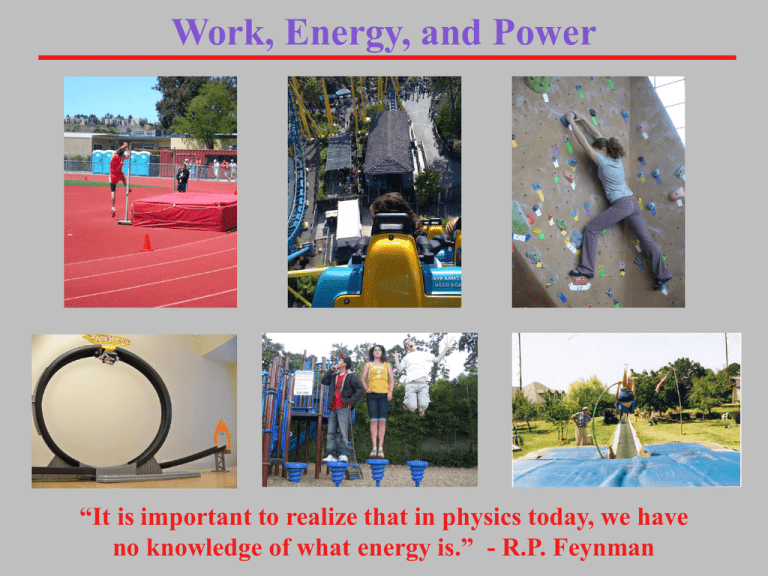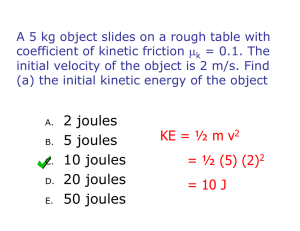Work,Energy,Power
advertisement

Work, Energy, and Power “It is important to realize that in physics today, we have no knowledge of what energy is.” - R.P. Feynman Work and Energy Work and Energy concepts (and also momentum, later) provide an alternative, easier approach to mechanics! WORK • Causes transfer of energy (between masses) or transforms energy (from one type to another). • work is the amount of energy transferred by forces. ENERGY • Measures a change in the condition of matter (change can be in velocity, position, mass, etc.) • There is no such thing as pure energy. Energy is the measure of a change (and force is the agent of the change). Energy Example: Driving a Car SPEED UP SLOW DOWN ‘ROUND A CORNER F d d F F F and d are parallel F and d are opposite car gains kinetic energy car loses kinetic energy d F and d are perpendicular car maintains kinetic energy Energy Example: The Launch of a Rocket LIFTOFF! d SPEED! Fa ORBIT! d d Fg Fa F and d are parallel F and d are parallel F and d are perpendicular rocket gains potential energy rocket gains kinetic energy rocket has constant energy (circular orbit) Work Work depends on three things: • force on an object W Fd cos • displacement of an object • angle between the force and displacement (force must cause the displacement) Units (metric or SI) click for applet click for applet 1 joule 1 newton 1 meter 1 N m • work is a scalar quantity, but can be positive, negative, or zero because it represents the amount of energy change. work is positive when 0˚≤ θ < 90˚ work is negative when 90˚< θ ≤ 180˚ work is zero when θ = 90˚ Fk Fn Fa PHYSICS Fg d Which force does positive work? Which does negative work? Which does zero work? Kinetic Energy Kinetic energy is the energy of motion of matter (translational) Kinetic Energy - depends on the motion of macroscopic objects (e.g. a car in motion) moving linearly Wnet Fd F ma Wnet mad v f 2 vi 2 2ad Wnet m 12 (v f 2 vi 2 ) work, dynamics, kinematics! KE 12 mv 2 Wnet KE in joules mass velocity WORK-ENERGY THEOREM Thermal Energy - depends on the motion of microscopic objects (e.g. atomic vibrations). Technically not the same as heat. in joules TE Fk d friction click for applet distance Potential Energy Potential energy is the energy of position of matter Gravitational Potential - depends on the position of mass in a gravitational field g field in joules GPE mgh mass height Elastic Potential - depends on the position of mass on an atomic scale in joules EPE 12 kx 2 spring position constant Power Power is the rate at which work is done (or energy is used) W P t click for web page Units (metric or SI) 1 watt 1 joule J 1 1 second s Power can also be expressed in terms of force and velocity W Fd cos P Fv t t Conservation of Mechanical Energy Mechanical energy is the sum of kinetic and potential energy. ME KE PE Conservative forces (gravity, spring force) keep mechanical energy constant. Potential and kinetic energy may change, but the total mechanical energy does not change. KEi PEi KE f PE f click for animation click for applet Conservation of Mechanical Energy Example A spring with constant 800 N/m is compressed 10 cm. It is released against a cart with mass of 0.25 kg that moves along a track without friction. What is the cart’s speed when it leaves the spring? EPEi KE f 1 2 1 2 kxi 2 12 mv f 2 (800)(0.10)2 12 (0.25)v f 2 v f 5.66 m/s At what height above the original release point does the cart come to rest? What is the cart’s speed when it reaches the top of a 0.75 m high hill? KEi KE f GPE f 1 2 mvi 2 12 mv f 2 mgh 1 2 (0.25)(5.66)2 12 (0.25)v f 2 (0.25)(9.8)(0.75) or 1 2 mvi 2 mgh f 1 2 (0.25)(5.66)2 (0.25)(9.8)h f h f 1.63 m 1 2 mvi 2 mghi mgh f where hi 0.75 m vi 4.16 m/s kxi mv f mgh 2 1 2 or v f 4.16 m/s 1 2 KEi GPE f 2 or 1 2 kxi 2 mgh f Law of Conservation of Energy Non-conservative forces (friction, applied, normal, tension) change the mechanical energy, but total energy remains constant. W KEi PEi KE f PE f TE result of applied or normal or tension result of gravity or spring force result of friction click for animation click for animation Law of Conservation of Energy Examples (Assume there is zero air friction in these problems) A 75-kg Olympic ski jumper starts h d sin 100 sin 30Þ 50 m from rest and glides down a 30˚ GPEi KE f TE incline 100-meter long. The track has surface friction. If the jumper leaves mghi 12 mv f 2 Fk d the track with a velocity of 28 m/s, (75)(9.8)(50) 12 (75)(28 2 ) Fk (100) what is the average force of kinetic friction on the skies from the track? Fk 73.5 N In frustration, a physics student shoves a 1.2-kg textbook with a force of 14 newtons across a 0.5 meter wide desk that has no surface friction. If the book lands on the ground with a velocity of 5.2 m/s, how high is the desk above the ground? Honors: A 400-g wood block is attached to a spring. The block can slide along a table with coefficient of friction 0.25. A force of 20 N compresses the spring 20 cm and the block is released. How far beyond the equilibrium position will the spring stretch? W GPEi KE f Fd cos mghi 12 mv f 2 (14)(0.5)cos 0Þ(1.2)(9.8)(hi ) 12 (1.2)(5.2 2 ) hi 0.784 m k Fsp / xi 20 / 0.2 100 N/m EPEi EPE f TE 1 2 kxi 2 12 kx f 2 Fk (xi x f ) Fk k mg (0.25)(0.4)(9.8) 0.98 N 1 2 (100)(0.2 2 ) 12 (100)(x f 2 ) (0.98)(0.2 x f ) x f 0.18 m




